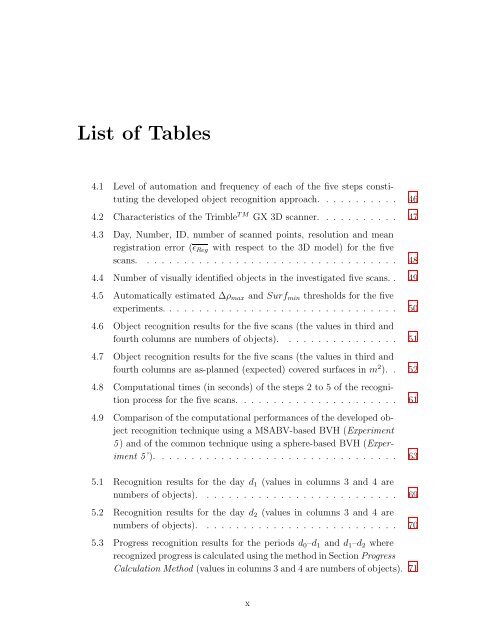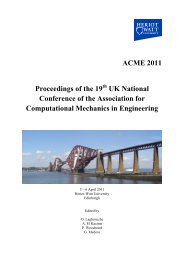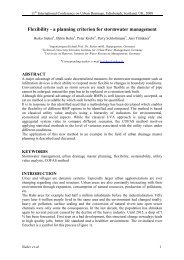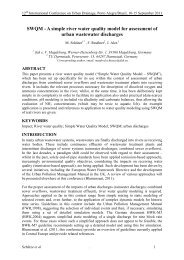PhD Thesis - Automated Recognition of 3D CAD Model Objects in ...
PhD Thesis - Automated Recognition of 3D CAD Model Objects in ...
PhD Thesis - Automated Recognition of 3D CAD Model Objects in ...
Create successful ePaper yourself
Turn your PDF publications into a flip-book with our unique Google optimized e-Paper software.
List <strong>of</strong> Tables<br />
4.1 Level <strong>of</strong> automation and frequency <strong>of</strong> each <strong>of</strong> the five steps constitut<strong>in</strong>g<br />
the developed object recognition approach. . . . . . . . . . . 46<br />
4.2 Characteristics <strong>of</strong> the Trimble TM GX <strong>3D</strong> scanner. . . . . . . . . . . 47<br />
4.3 Day, Number, ID, number <strong>of</strong> scanned po<strong>in</strong>ts, resolution and mean<br />
registration error (ɛReg with respect to the <strong>3D</strong> model) for the five<br />
scans. . . . . . . . . . . . . . . . . . . . . . . . . . . . . . . . . . . 48<br />
4.4 Number <strong>of</strong> visually identified objects <strong>in</strong> the <strong>in</strong>vestigated five scans. . 49<br />
4.5 Automatically estimated Δρmax and Surfm<strong>in</strong> thresholds for the five<br />
experiments. . . . . . . . . . . . . . . . . . . . . . . . . . . . . . . . 50<br />
4.6 Object recognition results for the five scans (the values <strong>in</strong> third and<br />
fourth columns are numbers <strong>of</strong> objects). . . . . . . . . . . . . . . . 51<br />
4.7 Object recognition results for the five scans (the values <strong>in</strong> third and<br />
fourth columns are as-planned (expected) covered surfaces <strong>in</strong> m 2 ). . 52<br />
4.8 Computational times (<strong>in</strong> seconds) <strong>of</strong> the steps 2 to 5 <strong>of</strong> the recognition<br />
process for the five scans. . . . . . . . . . . . . . . . . . . . . . 61<br />
4.9 Comparison <strong>of</strong> the computational performances <strong>of</strong> the developed object<br />
recognition technique us<strong>in</strong>g a MSABV-based BVH (Experiment<br />
5 ) and <strong>of</strong> the common technique us<strong>in</strong>g a sphere-based BVH (Experiment<br />
5’). . . . . . . . . . . . . . . . . . . . . . . . . . . . . . . . . 63<br />
5.1 <strong>Recognition</strong> results for the day d1 (values <strong>in</strong> columns 3 and 4 are<br />
numbers <strong>of</strong> objects). . . . . . . . . . . . . . . . . . . . . . . . . . . 69<br />
5.2 <strong>Recognition</strong> results for the day d2 (values <strong>in</strong> columns 3 and 4 are<br />
numbers <strong>of</strong> objects). . . . . . . . . . . . . . . . . . . . . . . . . . . 70<br />
5.3 Progress recognition results for the periods d0–d1 and d1–d2 where<br />
recognized progress is calculated us<strong>in</strong>g the method <strong>in</strong> Section Progress<br />
Calculation Method (values <strong>in</strong> columns 3 and 4 are numbers <strong>of</strong> objects). 71<br />
x













